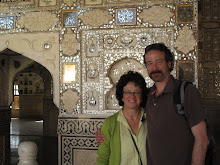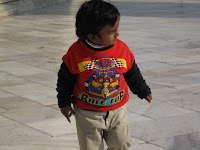
We flew from Goa back to Delhi again on SpiceJet (this time the flight was pretty much on schedule and uneventful) and a hotel driver met us at the airport to take us to the Park Plaza Hotel in Gurgaon, suburb of Delhi that looks like most U.S. Office Parks with high rises and malls... except for the shanties and makeshift slums nestled in between. The Park Plaza was a very sleek, efficient business hotel full of accidental tourists with a nice restaurant where we had no choice but to go that evening for dinner. We had wanted to go into Delhi but it would have taken about an hour in the endless traffic and we weren't sure where we would have gone once we got there. That was the drawback of this trip... remaining inside the bubble meant eating at the hotel, and while the food was very good, it didn't feel like we were really experiencing our surroundings. The
Lonely Planet suggestions were all for those who were willing to get their feet wet and more-than-likely to get sick.
The next morning at our usual breakfast buffet while chewing on a piece of roti, I felt and heard a crack as half of my molar broke off. I looked at Peter with such a stunned expression, I am sure he thought I must be having a stroke and my mind raced as I tried to comprehend what had just happened. With a gaping hole in my mouth and half of a tooth in my hand I knew this wasn't just going to go away. Our guide, Lalit, and driver, Jantin, were coming to pick us up that morning (it was Sunday) to drive to Jaipur, a four hour drive from Delhi. When Lalit arrived, I anxiously told him of my predicament, thinking that it would make sense to look for a dentist in Delhi, a city of 13 million people vs. Jaipur, pop. 2 million, but he wanted to get going to Jaipur saying that he had family there who could give us recommendations.
The drive to Jaipur on the "National Highway" is only about 125 miles but it takes 4 hours because for most of the time the Highway is a parking lot of cars, trucks, rickshaws, mototaxis, camel and buffalo carts, mopeds, motorbikes and people...more on traffic in an upcoming post!
We arrive in Jaipur at our last Carlson stay, the Country Inn and Suites, an 8-story high rise looming above the "pink city". After passing through a rigorous security check, I ask the lovely sari-clad women at the front desk if they can recommend a dentist and they tell they will research it and give me an answer later that day. We do a bit of preliminary sight seeing with our Jaipur guide, an Eddie Haskell-ish, smarmy character with pointy shoes and badly colored hair, and then return to the hotel to find out about dentists. They tell us they have found one right around the corner and we can go there now. So all four of us, Lalit, Jantin, Peter and me, drive around the corner to a sketchy-looking store front with a bright neon sign flashing "Gupta's Dental Care".
We proceed to the waiting room and an older woman tells us that the Doctor will be with us shortly. I look around at the walls and wonder if we are in the right place. It is clearly a waiting room for a medical doctor: are they one and the same in India?? Neither Lalit or Jantin seem to know either: I don't think they frequent these establishments very often. (we later find out that Gupta Sr. is the MD and Jr. is the DDS... as in most of India, it's all in the family.) After about an hour the woman comes out to tell us we can see Dr. Gupta now and instructs Peter and me to head up some stairs on the outside of the building to the Dental office. Dr. Basant Gupta, who looks about 17, greets us with a very confident and brisk manner and asks me to sit in his dental chair. It is a bare bones office, with one florescent light, a dental chair and sink, a desk and a TV turned to music videos (Beyonce is pictured here).

Dr. Gupta blasts a jet of air into my cracked tooth and I practically jump out of the chair. "We have to do a root canal" he pronounces. I protest and ask why we can't just do a temporary fix but he insists I will be in serious pain soon if I don't do anything and I can't really argue with that. He calls his endodontist friend who comes over in less than 15 minutes and they begin working on me for the next four hours. Peter stays with me, taking pictures and chatting with the two dentists, who are clearly happy to have a challenging case and a paying patient. As far as root canals go, this was really not too painful...although I did have to insist on another shot of Novocaine and the endodontist (a very serious fellow whose name I never got) kept asking me "is it paining?" as he stuck the needles further into the roots of my tooth. By 10:30 that evening (This is Sunday night but I have a feeling Dr. Gupta doesn't keep regular hours) I have a neatly cemented root canal and impressions of my tooth have been sent out for a crown to be implanted the next day...all for 34,000 INR's or about $600, which explains the burgeoning medical/dental tourism in this country. Although Dr. Gupta's specialty is cosmetic dentistry, he spends most of his time pulling teeth of his Indian patients because they can't afford anything else. No wonder he pulls out all the stops when he gets a willing and desperate American!
Postscript on my dental drama: after three weeks, my tooth is just fine; Dr. Gupta did an excellent job. The only residual effect is a very sore jaw joint from having held my jaw open for over four hours without the assistance of a dental block to allow the joint to rest. I guess that's a small price to pay for an adventure definitely worth writing home about!



























